


xxxxxEdward
Elgar, one of England’s greatest composers, is especially remembered
today for the rousing song Land of Hope and Glory,
- the first of his Pomp and Circumstance
Marches - and his Enigma Variations
of 1899, a series
of fourteen musical portraits of his friends, and containing a
hidden, mysterious theme, yet to be discovered. As a composer of
international stature, however, his reputation also rests upon his
wealth of orchestral and choral music, and the songs, chamber music
and piano and violin pieces that he composed throughout his career.
His celebrated oratorio, The Dream of Gerontius - based on a poem by the
churchman John Henry Newman - is seen by many as his
masterpiece, but his works also included concertos for violin and
cello, two symphonies (the first being particularly well received),
his Cockaigne Overture, his Introduction
and Allegro for strings, and his symphonic study Falstaff.
He gained immense popularity for his patriotic, stirring marches,
and became a symbol of patriotic pride, but he was essentially a
very private, reserved person, and many of his works, though large
and bold in form, are contemplative in nature and lyrical in tone.
In 1920, following the death of his wife - who had encouraged
and supported him throughout his career - he retired from
public life and virtually stopped composing. His works gave new
birth to English music, and paved the way for composers like Vaughan
Williams and Benjamin Britten. He was close friend of the Irish
playwright Bernard Shaw, and he visited the English composer
Frederick Delius the year before his death in 1934.
EDWARD WILLIAM ELGAR 1857
- 1934
(Va, Vb,
Vc, E7, G5)
Acknowledgements
Elgar: by the
English artist Edgar Thomas Holding (1876-1952), c1905 –
National Portrait Gallery, London. Wood:
detail, by the English photographer Ernest Walter Histed (1862-1947),
c1906, contained in The Musical Times,
March 1911. Delius: by the London
photographers Elliot & Fry (1863-1963), c1923 – National
Portrait Gallery, London. Church: by the
artist Charles Burton (active 1823-1839), published in Lithographic Views of all the Churches and Chapels
of Ease in the County of Surrey,
by the London surveyor Charles Thomas Cracklow (1763-1826),
1824 – Yale Centre of British Art, New Haven, CT, USA.
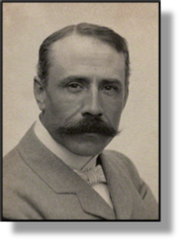
xxxxxIt was not
until 1899, at the age of 42, that Edward Elgar, one of England’s
greatest composers, gained overnight fame with his Enigma
Variations. Two years later his reputation soared to new
heights with the first of his Pomp and
Circumstance Marches, a rousing tune which, put to words
in 1902, became the patriotic song Land of
Hope and Glory. But as a composer his reputation also
rests upon his wealth of orchestral and choral work, beginning
with his celebrated oratorio The Dream of
Gerontius in 1900.
xxxxxElgar was
born at Broadheath, a small village near Worcester, and was
brought up in a musical environment. His father, a piano tuner by
trade, was an accomplished violinist, owned a music shop in town,
and was organist at the St. George’s Roman Catholic Church in
Worcester. He gave his son piano and violin lessons, and
encouraged his early efforts in composition. This apart, Elgar had
no formal training, and virtually taught himself to play various
instruments and gain a knowledge of musical theory. He was
composing little pieces by the age of 12 (such as The
Wand of Youth for a home-made play) and by the time
he left school he was an excellent violinist and a proficient
pianist, organist and bassoon player. He started out working in a
solicitor’s office, but he soon left to take up a musical career.
“There is music in the air, “ he later declared, “the world is
full of it”.
xxxxxOver the
next seventeen years he gave piano and violin lessons, and filled
his spare time composing, playing and conducting in local
orchestras, bands and chamber groups. He played bassoon in a wind
quintet made up of his family and friends; was conductor of the
Worcester Glee Club; conducted the band at the county lunatic
asylum at Powick; and in 1879 became a violinist in the Worcester
Philharmonic orchestra. In 1883 a Birmingham orchestra in which he
was playing as a violinist, gave the first public performance of
his Sérénade mauresque, and two years
later he succeeded his father as organist at St. George’s Church.
And during this time he made visits to Paris and Leipzig and came
under the influence of Richard Strauss. These were busy and, to
some extent, happy years, but they brought him no success as a
composer. In 1884 he wrote, “My prospects are as hopeless as
ever.”
xxxxxBut, given
time, all this was to change. In 1889 he married Caroline Alice
Roberts, one of his students. A daughter of the late Major General
Sir Henry Roberts, her family did not approve of the marriage, but
it proved the making of Elgar. Her love, support and encouragement
gave him renewed hope and inspiration. She had high hopes for him,
and this gave him the confidence he needed. He now devoted himself
to composing, and for the next year or so they settled in London
to be at the centre of the musical world. In fact, it served no
purpose, but on his return to Worcester and the Malvern Hills he
loved so much, his fortunes began to change. His
Froissart Overture, which had
been included in the Three Choirs Festival the previous year, was
acclaimed for its masterly orchestration, and his large works for
chorus and orchestra that followed - notably The
Black Knight and King
Olaf, both based on the poetry of Longfellow, and the
oratorio The Light of Life
- attracted more attention and added to his growing
reputation.
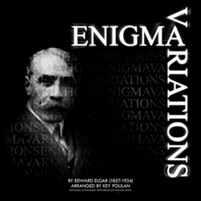
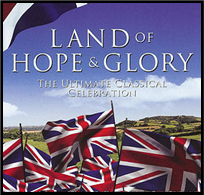 xxxxxThe breakthrough which was to bring him national and
international fame came in 1899 when
the famous Hungarian conductor Hans Richter gave the first
performance of his orchestral work Variations
on an Original Theme in London. Composed as a musical
portrait of his friends, the fourteen variations - finely
woven together and full of charm and originality - were
enthusiastically received, and brought him recognition as a
leading composer. And the success of these musical portraits was
further heightened by a hidden theme which Elgar ran through the
pieces. Still not discovered, this touch of mystery gave the work
its popular title - The Enigma Variations.
Two years later his reputation soared to new heights with the
first of his Pomp and Circumstance
Marches. Put to words the following year and known today
as Land of Hope and Glory,
it captured to the full the feeling of national pride and imperial
spirit abroad at that time. Recognised by Elgar himself as “a tune
that comes once in a lifetime”, it made him a national hero and
the march itself a national anthem in all but name.
xxxxxThe breakthrough which was to bring him national and
international fame came in 1899 when
the famous Hungarian conductor Hans Richter gave the first
performance of his orchestral work Variations
on an Original Theme in London. Composed as a musical
portrait of his friends, the fourteen variations - finely
woven together and full of charm and originality - were
enthusiastically received, and brought him recognition as a
leading composer. And the success of these musical portraits was
further heightened by a hidden theme which Elgar ran through the
pieces. Still not discovered, this touch of mystery gave the work
its popular title - The Enigma Variations.
Two years later his reputation soared to new heights with the
first of his Pomp and Circumstance
Marches. Put to words the following year and known today
as Land of Hope and Glory,
it captured to the full the feeling of national pride and imperial
spirit abroad at that time. Recognised by Elgar himself as “a tune
that comes once in a lifetime”, it made him a national hero and
the march itself a national anthem in all but name.
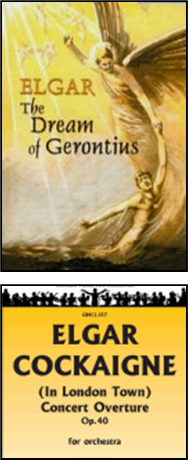
xxxxxBut
jingoism - the extreme patriotism associated with the likes
of Rudyard Kipling - was not in Elgar’s nature. He was a
quiet, introspective and, at times, melancholy man, and the bulk
of his works are contemplative, serious studies, many with
religious overtones. His major work, the oratorio The
Dream of Gerontius, composed a year
before his pomp and circumstance march, has passages of extreme
beauty and grandeur. Based on a poem by the churchman John Henry Newman, it traces the
journey of a man’s soul’s to his judgement before God and his
entry into Purgatory. There followed, in the early 1900s, the
religious oratorios The Apostles and The Kingdom, concertos for violin and cello,
two symphonies (the first particularly successful), the buoyant Cockaigne Overture (In
London Town), the Introduction and
Allegro for Strings, and the long symphonic poem Falstaff.
And to this must be added the completion of his five pomp and
circumstance marches, and a wealth of chamber music (including a
piano and violin sonata), songs (such as the cycle Sea
Pictures), church music, and delightful violin and piano
pieces. Notable in the last category is his Salut
d’amour, a tender, sentimental piece composed as an
engagement present to his wife to be in 1888.
xxxxxIn
particular, the period 1904 to 1914 were years of phenomenal
success. In 1904 The Elgar Festival at Covent Garden Theatre,
London, attended by the King and Queen, confirmed his place among
the great English composers, and he was knighted later that year.
From 1905 to 1908 he was Birmingham University’s first professor
of music, and he received an honorary degree from Yale University
in 1905 during one of his four visits to the United States. He
composed music for both the coronation and funeral of Edward VII,
and in 1911 was awarded the Order of Merit by King George V.
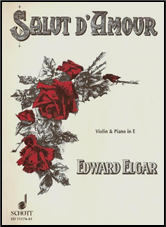 xxxxxDuring the First World War (1914-1918) Elgar
wrote a few patriotic pieces, but the huge loss of life incurred
during this conflict distressed him. He ended his career as a
composer with his cello concerto, a haunting, beautiful and
poignant work, first performed in 1919. The death of his wife the
following year was a blow from which he never recovered. She had
been his inspiration, and her faith in his ability - his
“genius” as she put it - had never faltered. He then went
into virtual retirement, returning to his beloved Worcestershire
to live the lonely life of a country gentleman. He produced a few
small pieces and some incidental music, but no work of any
significance. However, he continued to receive honours. He was
appointed master of the King’s Musick in 1924, and made a baronet
in 1931. At the instigation of the Irish playwright Bernard Shaw -
a friend to whom he had dedicated his Severn
Suite in 1930 - he did begin composing again and, at
his death in 1934, he left unfinished a third symphony and an
opera entitled The Spanish Lady, based
on The Devil is an Ass, a play by the
English poet and dramatist Ben Jonson. Elgar died at Worcester and
was buried at St. Wulstan’s Church in Little Malvern, next to his
wife.
xxxxxDuring the First World War (1914-1918) Elgar
wrote a few patriotic pieces, but the huge loss of life incurred
during this conflict distressed him. He ended his career as a
composer with his cello concerto, a haunting, beautiful and
poignant work, first performed in 1919. The death of his wife the
following year was a blow from which he never recovered. She had
been his inspiration, and her faith in his ability - his
“genius” as she put it - had never faltered. He then went
into virtual retirement, returning to his beloved Worcestershire
to live the lonely life of a country gentleman. He produced a few
small pieces and some incidental music, but no work of any
significance. However, he continued to receive honours. He was
appointed master of the King’s Musick in 1924, and made a baronet
in 1931. At the instigation of the Irish playwright Bernard Shaw -
a friend to whom he had dedicated his Severn
Suite in 1930 - he did begin composing again and, at
his death in 1934, he left unfinished a third symphony and an
opera entitled The Spanish Lady, based
on The Devil is an Ass, a play by the
English poet and dramatist Ben Jonson. Elgar died at Worcester and
was buried at St. Wulstan’s Church in Little Malvern, next to his
wife.
xxxxxElgar’s work showed an outstanding mastery of
orchestration, and his music, a late example of romanticism, had a
distinctive English feel about it, born of a deep love for his
native land. His five Pomp and Circumstance
Marches in particular made him a symbol of national
pride, echoing the ceremony and majesty of the British Empire -
then at its height -, but much of his orchestral and choral
work, though large and bold in form, is contemplative by nature
and both lyrical and sensitive in tone. As the first English
composer to gain international recognition since Henry Purcell in
the 17th century, he gave new birth to English music, and paved
the way for composers such as Vaughan Williams and Benjamin
Britten. And as a conductor of some standing, he inspired the
likes of Adrian Boult and Malcolm Sargent.
xxxxxIncidentally, Elgar was the first major composer to record his
own compositions on the phonograph. The recordings were carried
out at the Abbey Road Studios in St. John’s Wood, London, later
made famous by the pop group The Beatles in the 1960s. ……
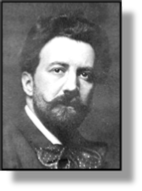
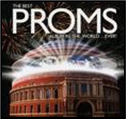 xxxxx……xxThexrousing tune Land of Hope and
Glory is a popular fixture at the last night of the so-called
Proms, a series of Promenade Concerts originated by the English
conductor Henry
Wood (1869-1944)
(illustrated)
in 1895. Now held annually at the Royal Albert Hall, the audience
was originally free to walk about during the performance, hence the
word “promenade”. The words of the song were written by the poet and
essayist Arthur C. Benson
(1862-1925) in 1902. ……
xxxxx……xxThexrousing tune Land of Hope and
Glory is a popular fixture at the last night of the so-called
Proms, a series of Promenade Concerts originated by the English
conductor Henry
Wood (1869-1944)
(illustrated)
in 1895. Now held annually at the Royal Albert Hall, the audience
was originally free to walk about during the performance, hence the
word “promenade”. The words of the song were written by the poet and
essayist Arthur C. Benson
(1862-1925) in 1902. ……
xxxxx……xxAnd another of Elgar’s
compositions, Nimrod, one of his Enigma Variations, is always played at the
ceremony at the Cenotaph in London on Remembrance Sunday in
November, and it is often
heard at funerals and other solemn occasions. ……
xxxxx……xxSome of his finest
marches were composed for royal occasions. His Imperial
March was written for Queen Victoria’s Diamond Jubilee in
1897, and his Coronation March for the
coronation of George V in 1911. ……
xxxxx……xxElgar’sxViolin
Concerto was dedicated to Fritz Kreisler (1875-1962),
the Austrian composer and violin virtuoso who gave the first
performance of the work in 1910. ……
xxxxx……xxElgar had one child, a
daughter born in London in August 1890. She was given the name
Carice, a contraction of her mother’s two names Caroline and
Alice. ……
xxxxx……xxThe Elgar Visitor Centre
is well worth a visit. Situated at the small cottage where he was
born, it provides a fascinating insight not only into his life as
a musician, but also into the man himself. He delighted in nature,
and as a young man loved to walk the Malvern Hills and cycle along
the lanes of Worcestershire and Herefordshire. He was fond of
puzzles and puns, often drew amusing cartoons and sketches, and in
his later years took a keen interest in science and technology.
Vc-1881-1901-Vc-1881-1901-Vc-1881-1901-Vc-1881-1901-Vc-1881-1901-Vc-1881-1901-Vc
Including:
Frederick
Delius

xxxxxContemporary
with Edward Elgar was the English-born composer Frederick
Delius (1862-1934), whom Elgar visited
during a visit to France in 1933. He also played a major part in the
revival of English music at the end of the 19th century. After a
brief stay in Florida he spent most of his career in France, and it
was there that he composed his major works, the majority inspired by
his love of nature - such as the woods and fields of France and
England, the mountains of Norway, and the lush Everglades in
Florida. Among his most successful works were the operas Koanga
and A Village Romeo and Juliet, the choral
pieces Appalachia and Sea
Drift, and In a Summer Garden, Song of the High Hills, and On
hearing the first Cuckoo in Spring. However, it was not
until he was in his early 40s (as in the case of Elgar) that he
gained wide recognition as a composer of distinction. He first found
favour in Germany and then, with the enthusiastic support of the
English conductor Thomas Beecham, became very popular in England. He
was initially influenced by the works of Wagner, Grieg and Debussy,
but he developed a very personal, impressionistic style, noted for
its flow of rich harmonies. Music, he maintained, had to be
concerned with emotions, describing those things which could not be
captured in any other way. For the last ten years of his life he was
blind and partially paralysed, but he continued composing with the
help of a young musician named Eric Fenby. He was befriended by
Edvard Grieg early in his career.
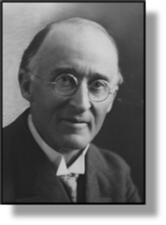 xxxxxAnother outstanding
English-born composer at this time was Frederick
Delius (1862-1934), whom Elgar
visited when in France the year before his death. Like Elgar, he
played a major part in the revival of English music at the end of
the 19th century, but he spent much of his life in France and,
despite the distinctive quality of his music, never received the
high degree of popularity enjoyed by his contemporary.
xxxxxAnother outstanding
English-born composer at this time was Frederick
Delius (1862-1934), whom Elgar
visited when in France the year before his death. Like Elgar, he
played a major part in the revival of English music at the end of
the 19th century, but he spent much of his life in France and,
despite the distinctive quality of his music, never received the
high degree of popularity enjoyed by his contemporary.
xxxxxDelius was
born in Bradford, Yorkshire, of German parents. He was educated at
Bradford Grammar School and the International College at
Isleworth, London, and then joined his father’s business in the
wool trade. He showed no interest in commerce, however, and having
become proficient as a violinist and pianist, decided to make
music his career. Actingxagainst his
father’s wishes, he took himself off to Florida, together with a
friend, and worked as an orange grower while taking lessons in
music from Thomas F. Ward
(1856-1912), a talented organist living in Jacksonville.
Then, after a short while teaching music and paying a brief visit
to New York, he returned to Europe in 1886.
xxxxxHe studied
for a while at Leipzig Conservatory - though he was not over
impressed with the training! - and it was while there that he
was befriended by Edvard Grieg. The Norwegian composer not only
encouraged him in his work, furthering his romantic style, but
also persuaded Delius’ father to allow his young son to take up a
career as a composer. From then on Delius had no money worries and
no need to stay in England. Having no real attachment to his
country of birth, Delius visited Paris in 1888 and decided to make
his home in France. He lived mainly in Paris, but in 1897 he
settled at Grez-sur-Loing, a village near Fontainebleau,
setting up home with the artist Jelka Rosen (whom he married in
1904)
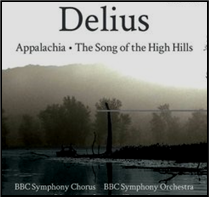 xxxxxHis move to France marks the beginning of his mature
composition. He had composed his attractive Florida
Suite while in Leipzig, but he now embarked upon a series
of ambitious works which would eventually bring him international
fame. To this early period in France belongs his operas Koanga
and A Village Romeo and Juliet, the
orchestral work Paris - Song of a Great
City, his choral pieces Appalachia (Variations on a slave song), and Sea
Drift for baritone and orchestra, Brigg
Fair, based on an English folksong, In
a Summer Garden, and Song of the High
Hills.
xxxxxHis move to France marks the beginning of his mature
composition. He had composed his attractive Florida
Suite while in Leipzig, but he now embarked upon a series
of ambitious works which would eventually bring him international
fame. To this early period in France belongs his operas Koanga
and A Village Romeo and Juliet, the
orchestral work Paris - Song of a Great
City, his choral pieces Appalachia (Variations on a slave song), and Sea
Drift for baritone and orchestra, Brigg
Fair, based on an English folksong, In
a Summer Garden, and Song of the High
Hills.
xxxxxAt first
these works made no impression. Like Elgar, he was in his early
40s before he gained any real measure of success, and by that time
he had composed five operas, six large orchestral works, and a
large number of songs. Recognition of his worth, when it came,
began in Germany where, from 1897 onwards, his major works were
played for the first time and began to find favour with conductors
and public alike.
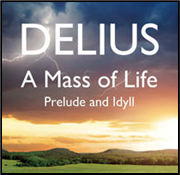
xxxxxThenxin 1907 he met the English conductor Thomas
Beecham (1879-1961) and, through
his enthusiastic support, his works grew progressively popular in
England. Beecham conducted Paris and Sea Drift in London the following year, and
in 1909 gave the first performance of his choral work A
Mass of Life, based on
the treatise Thus Spoke Zarathustra by
the German philosopher Friedrich Nietzsche.
xxxxxBy 1916,
with the completion of his Violin Concerto,
the most successful part of his career was at an end. After the
First World War (1914-1918) he paid a number of visits to
England, but tragedy struck at the age of 60. It was then that he
contracted syphilis and over the next four years he became totally
blind and partially paralysed. However,zhe
continued to compose with the assistance of a young English
musician named Eric Fenby
(1906-1997). He acted as his amanuensis from 1928 until the
composer’s death in 1934. Delius died at Grez-sur-Loing,
but he was buried at the Norman parish church of St Peter’s at
Limpsfield in Surrey, England. His other works included concertos
for piano, violin and cello, chamber music, songs, and two dance
rhapsodies.
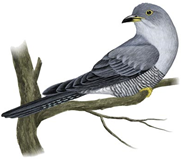
xxxxxIn his
music Delius broke away from the established form. He was
doubtless inspired earlier by the works of Wagner, Grieg, and
Debussy, and there are hints of their influence at times, but
throughout his career he belonged to no school or movement. He
followed his own star, guided by a highly personal,
impressionistic style. In subject matter his compositions were
largely inspired by his great love of nature - be it the
lakes and mountains of Norway, the woods and green fields of
France and England, or the lush everglades of Florida - and
these scenes were portrayed in a flow of rich harmonies, often
passionate, often delicate, and sometimes haunting. Music, he
argued, must be concerned with the emotions, describing scenes and
moods which cannot be explained in any other way. In his lovely
tone poem On Hearing the First Cuckoo in
Spring, for example, composed in 1912 and now one of his
best known works, he conjures up in soft, lyrical tones the very
atmosphere of a day in Spring. Thomas Beecham, who did so much to
promote and popularize his music, described him as “the last
apostle in our time of romance, beauty and emotion in music”.
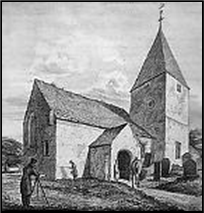
xxxxxIncidentally, when in Paris in the early 1990s Delius met up with
the post-impressionist artist Paul Gauguin and the French
composer Maurice Ravel. ……
xxxxx…… When Sir Thomas Beecham (he was knighted in 1916)
died in 1961 he was also buried in the parish church at
Limpsfield, just a few yards from the man whom he had helped to
fame.








 xxxxxThe breakthrough which was to bring him national and
international fame came in 1899 when
the famous Hungarian conductor Hans Richter gave the first
performance of his orchestral work Variations
on an Original Theme in London. Composed as a musical
portrait of his friends, the fourteen variations -
xxxxxThe breakthrough which was to bring him national and
international fame came in 1899 when
the famous Hungarian conductor Hans Richter gave the first
performance of his orchestral work Variations
on an Original Theme in London. Composed as a musical
portrait of his friends, the fourteen variations -
 xxxxxDuring the First World War (1914-
xxxxxDuring the First World War (1914-
 xxxxx……xxThexrousing tune Land of Hope and
Glory is a popular fixture at the last night of the so-
xxxxx……xxThexrousing tune Land of Hope and
Glory is a popular fixture at the last night of the so-
 xxxxxAnother outstanding
English-
xxxxxAnother outstanding
English- xxxxxHis move to France marks the beginning of his mature
composition. He had composed his attractive Florida
Suite while in Leipzig, but he now embarked upon a series
of ambitious works which would eventually bring him international
fame. To this early period in France belongs his operas Koanga
and A Village Romeo and Juliet, the
orchestral work Paris -
xxxxxHis move to France marks the beginning of his mature
composition. He had composed his attractive Florida
Suite while in Leipzig, but he now embarked upon a series
of ambitious works which would eventually bring him international
fame. To this early period in France belongs his operas Koanga
and A Village Romeo and Juliet, the
orchestral work Paris -




